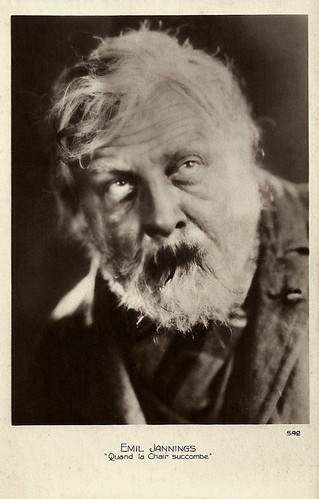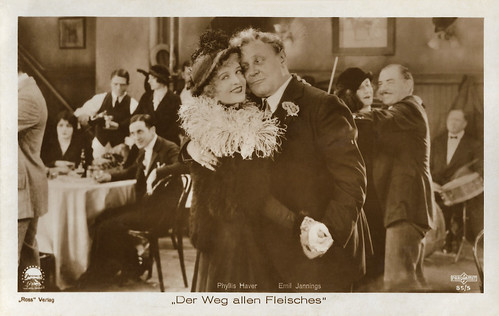The Way of All Flesh (Victor Fleming, 1927) is one of the famous lost films. Only a fragment of 8,5 minutes of the film has turned up. One of the assets of the film was the powerful performance of German actor Emil Jannings. It was his first Hollywood film and his portrayal is reminiscent of his characters in his previous German films, Der letzte Mann/The Last Laugh (F.W. Murnau, 1924) and Variété/Variety (E.A. Dupont, 1925). Jannings won the first Academy Award as Best Actor for his roles in both The Way of All Flesh (1927) and The Last Command (Ernst Lubitsch, 1928).

French postcard by Editions Cinémagazine, no. 542. Photo: Emil Jannings in Quand la Chair succombe/The Way of All Flesh (Victor Fleming, 1927).

Italian postcard by G.B. Falci, Milano, no. 271. Photo: Paramount. This is Phyllis Haver, not Belle Bennett. This portrait is from the film Nel gorgo del peccato/The Way of All Flesh (Victor Fleming, 1927) in which the two actresses starred together. Collection: Marlene Pilaete.
The Way of All Flesh (Victor Fleming, 1927) is based on a story by Perley Poore Sheehan, adapted by Lajos Biró. The film opens in the early 1900s. Emil Jannings plays August Schiller, a bank clerk in Milwaukee who is happy with both his job and with his dear wife Belle Bennett and their six children.
But when bank officials ask him to transport $1,000 in securities to Chicago, he meets on the train a bleached blonde seductress (Phyllis Haver), who catches a glimpse of what he is carrying. She flirts with him, convinces him to buy her a bottle of champagne, and takes him to a saloon run by a crook (Fred Kohler).
The next morning he awakes alone in a dilapidated bedroom, without the money. He finds the woman, and at first pleads with her, then intimidates her to return the stolen securities. He is knocked unconscious by the saloon owner and dragged to a nearby railroad track.
As the crook strips him of everything that might lead to his identification, Schiller recovers consciousness, and in a struggle, the crook falls on the path of an oncoming train and is killed. The desperate Schiller flees and wants to take his own life. Then he reads in a newspaper that he is supposedly dead, the crook's mangled body having been identified as Schiller's. Jannings decides to go along with the story to spare his family embarrassment and scandal.
The time passes to twenty years later. Schiller is aged and unkempt, employed to pick up trash in a park. He sees his own family go to a cemetery and place a wreath on his grave. Later in a Christmas snowstorm, Schiller makes his way to his former home. He sees that the son (Donald Keith) whom he had taught to play the violin is now a successful musician. He walks away, carrying in his pocket a dollar that his son has given him, not recognising that the old tramp is his father.
In 1940, the film was remade by Paramount as The Way of All Flesh (Louis King, 1940) with Akim Tamiroff, Gladys George, and Muriel Angelus.

German postcard by Ross Verlag, no. 85/1. Photo: Parufamet. Emil Jannings in The Way of All Flesh (Victor Fleming, 1927).

German postcard by Ross Verlag, no. 85/2. Photo: Parufamet. Belle Bennett and Emil Jannings in The Way of All Flesh (Victor Fleming, 1927).

German postcard by Ross Verlag, no. 85/3. Photo: Parufamet. Emil Jannings and Phyllis Haver in The Way of All Flesh (Victor Fleming, 1927).

German postcard by Ross Verlag, no. 85/4. Photo: Parufamet. Emil Jannings and Phyllis Haver in The Way of All Flesh (Victor Fleming, 1927).

German postcard by Ross Verlag, no. 85/5. Photo: Parufamet. Emil Jannings and Phyllis Haver in The Way of All Flesh (Victor Fleming, 1927).
The surviving fragment of The Way of All Flesh (1927). Source: da218835 (YouTube).
Sources: Janiss Garza (AllMovie), Wikipedia, and IMDb.

French postcard by Editions Cinémagazine, no. 542. Photo: Emil Jannings in Quand la Chair succombe/The Way of All Flesh (Victor Fleming, 1927).

Italian postcard by G.B. Falci, Milano, no. 271. Photo: Paramount. This is Phyllis Haver, not Belle Bennett. This portrait is from the film Nel gorgo del peccato/The Way of All Flesh (Victor Fleming, 1927) in which the two actresses starred together. Collection: Marlene Pilaete.
The old tramp in the Christmas snowstorm
The Way of All Flesh (Victor Fleming, 1927) is based on a story by Perley Poore Sheehan, adapted by Lajos Biró. The film opens in the early 1900s. Emil Jannings plays August Schiller, a bank clerk in Milwaukee who is happy with both his job and with his dear wife Belle Bennett and their six children.
But when bank officials ask him to transport $1,000 in securities to Chicago, he meets on the train a bleached blonde seductress (Phyllis Haver), who catches a glimpse of what he is carrying. She flirts with him, convinces him to buy her a bottle of champagne, and takes him to a saloon run by a crook (Fred Kohler).
The next morning he awakes alone in a dilapidated bedroom, without the money. He finds the woman, and at first pleads with her, then intimidates her to return the stolen securities. He is knocked unconscious by the saloon owner and dragged to a nearby railroad track.
As the crook strips him of everything that might lead to his identification, Schiller recovers consciousness, and in a struggle, the crook falls on the path of an oncoming train and is killed. The desperate Schiller flees and wants to take his own life. Then he reads in a newspaper that he is supposedly dead, the crook's mangled body having been identified as Schiller's. Jannings decides to go along with the story to spare his family embarrassment and scandal.
The time passes to twenty years later. Schiller is aged and unkempt, employed to pick up trash in a park. He sees his own family go to a cemetery and place a wreath on his grave. Later in a Christmas snowstorm, Schiller makes his way to his former home. He sees that the son (Donald Keith) whom he had taught to play the violin is now a successful musician. He walks away, carrying in his pocket a dollar that his son has given him, not recognising that the old tramp is his father.
In 1940, the film was remade by Paramount as The Way of All Flesh (Louis King, 1940) with Akim Tamiroff, Gladys George, and Muriel Angelus.

German postcard by Ross Verlag, no. 85/1. Photo: Parufamet. Emil Jannings in The Way of All Flesh (Victor Fleming, 1927).

German postcard by Ross Verlag, no. 85/2. Photo: Parufamet. Belle Bennett and Emil Jannings in The Way of All Flesh (Victor Fleming, 1927).

German postcard by Ross Verlag, no. 85/3. Photo: Parufamet. Emil Jannings and Phyllis Haver in The Way of All Flesh (Victor Fleming, 1927).

German postcard by Ross Verlag, no. 85/4. Photo: Parufamet. Emil Jannings and Phyllis Haver in The Way of All Flesh (Victor Fleming, 1927).

German postcard by Ross Verlag, no. 85/5. Photo: Parufamet. Emil Jannings and Phyllis Haver in The Way of All Flesh (Victor Fleming, 1927).
The surviving fragment of The Way of All Flesh (1927). Source: da218835 (YouTube).
Sources: Janiss Garza (AllMovie), Wikipedia, and IMDb.
No comments:
Post a Comment